

By Orie Endo (遠藤織枝), Bunkyo University (文教大学), Japan
Presented at Association of Asian Studies Annual Conference (March, 1999).
IntroductionIn the first part of my presentation, I will briefly explain what is known about the history of Nushu女書 and then in the later, I will talk about Nushu today and contemporary problems surrounding its preservation. My paper will address the following:
1.) Area of Distribution and Environment of Nushu
2.) Nushu: an Introduction to the Script
3.) The Lives of Women of the Area Before Communism
4.) The Creation and Development of Nushu
5.) Nushu Today and its Contemporary Transmitters, and
6.) The significance of Nushu
1. Area of Distribution and Environment of Nushu
 Historical distribution of Nushu is shown on the figure. The map marked
No. 1 is of China; No. 2 is of the province of Hunan湖南省; and No. 3 is of the
prefecture of Jiang Yong江永県, found in south- eastern Hunan. The area of this
prefecture 1627 km2 and the population is approximately 230,000. The distribution of
Nushu is indicated by the dotted area.
Historical distribution of Nushu is shown on the figure. The map marked
No. 1 is of China; No. 2 is of the province of Hunan湖南省; and No. 3 is of the
prefecture of Jiang Yong江永県, found in south- eastern Hunan. The area of this
prefecture 1627 km2 and the population is approximately 230,000. The distribution of
Nushu is indicated by the dotted area.
The region is both fertile and surrounded by mountains. The lowlands are mainly inhabited by the Han 漢族people and the mountains by the Yao瑶族. Historically, social and cultural interchange and intermarriage between the two ethnic groups have been the norm. They have enjoyed a peaceful coexistence over the years and there are many examples of cultural fusion.
Generally, the Han are phlegmatic, plain in dress, and hard-working; whereas the Yao are sanguine, tend to bright colors, and greatly enjoy impromptu composition of poetry, and song and dance.
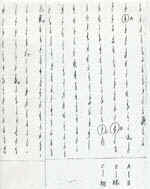 2. Nushu: an Introduction to the Script
2. Nushu: an Introduction to the Script
The example of the Nushu script is shown in figure. The script is written from top to bottom and right to left. Many of the characters resemble those of Hanzi漢字 or Chinese characters. Small, thin strokes are considered the mark of a skilled hand. According to the work of Chinese researchers thus far, the script is thought to be comprised of 1000-1500 characters.
The next one is an example of some
of the joint research done by Professors Zhao Li Ming趙麗明 and Gong Zhe Bing宮哲兵.
If you compare the characters in box number one with each other, you will see that they
are very similar.  The characters enclosed by
boxes marked three, four and five could be taken as the same characters respectively,
however in this case, Professors Zhao and Gong, too, have chosen to count them all as
different characters.
The characters enclosed by
boxes marked three, four and five could be taken as the same characters respectively,
however in this case, Professors Zhao and Gong, too, have chosen to count them all as
different characters.
When researchers count as different Nushu characters what actually are variants, the total number can easily be inflated to 1000 or more. It is important to realize that these variants are products of different writing styles and methods of transmission. In the examples you have just seen, what have been taken to be different characters all have the same pronunciation and function. It is my view that characters that are similar to each other except for a few minor strokes or seraphs, that represent the same sounds, and that have perform the same function in a writing system, are, in reality, variants of the same character.
The third one is the alphabet
examples of the Chinese hanzi, Japanese kanji漢字 and hiragana平仮名. Each
character has been written twice but in a different style. Although they vary from each
other slightly, 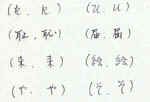 we do not consider each
variant a different character. Upon reflection, I have come to the conclusion that the
collection, compilation and analysis of the aggregation of materials from a number of
different writers of Nushu has resulted in an inflation of the number of characters
women used to express themselves in the script. Based on this I have done preliminary
research on the body of writings from one transmitter alone, that being Ms. He Yan-xin何艶新, and
the results show that she uses approximately 550 characters.
we do not consider each
variant a different character. Upon reflection, I have come to the conclusion that the
collection, compilation and analysis of the aggregation of materials from a number of
different writers of Nushu has resulted in an inflation of the number of characters
women used to express themselves in the script. Based on this I have done preliminary
research on the body of writings from one transmitter alone, that being Ms. He Yan-xin何艶新, and
the results show that she uses approximately 550 characters.
3. The Lives of Women of the Area Before Communism
In comparison to women in other villages in China, the women of the area were blessed with an exceptional environment. The region was and still is warm, the soil fertile, and water plentiful. There was no need for women to do agricultural work: the labour of men generally sufficed. Crop harvests were abundant.
There was a distinct division of labour. While the men farmed, women busied themselves with Nuhong女紅--texile arts and crafts that included spinning cotton thread, weaving, sewing, shoe-making from cloth, and embroidery. With the men tending the fields, women friends would often gather at one person's home and do their work together. Loving poetry and song, the women often recited or sang of their sorrows or joys alone or in chorus, and it is likely that they did so as they worked.
Also, it was popular among the girls of this area to observe a custom called Jiebai Zimei 結拝姉妹or sworn sisterhood which entails pledging commitment to female friends who were not blood relations. These "sworn sisters" would go to festivals at the village shrine together, do Nuhong together, and generally were much closer to each other than they were to their real sisters.
Although the lives of these girls in the villages of their birth were quite idyllic, a move to a different village and the hell of married life awaited. When girls came of age, they were forced to go to the homes of men they had never seen before to become their brides; they were teased and bullied by their mothers-in-law and worked to the bone around the house. Even when a young woman gave the family children, they would often be sickly. Many died at a very young age. The life a married woman was difficult, indeed.
However, what seemed to be the most unbearable of all for the young women of this area, was having to part from their Jiebai Zimei or "sworn sisters". They would compose songs expressing their sorrow, however, once separated, they could not, of course, sing together, nor could their voices travel the distances between villages. It can be hypothesized that the origin of this script can be found in the fervent desire to somehow express their feelings to each other, to find a way in which to communicate.
4. The Creation and Development of Nushu
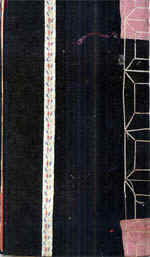 Nushu was mainly used in the creation of San Chao Shu三朝書 or
"Third Day Missives".
Nushu was mainly used in the creation of San Chao Shu三朝書 or
"Third Day Missives".
San Chao Shu were cloth bound booklets created by Jiebai Zhimei and mothers to give to their counterpart Jiebai Zhimei or their daughters, respectively, upon their marriage. Jiebai Zhimei and mothers expressed their hopes for the happiness of the young woman who had left the village to be married and their sorrow at being parted from her, by writing down songs in Nushu in San Chao Shu which were then delivered on the third day after the young woman's marriage.
 San Chao Shu were often highly decorated in ink or with paper cutouts
as you see here.Both side of the first three pageswould be filled with songs written for
the young women who left the village,while the rest was left blank. San chao shu ere
considered perspnal treasures and those who received them would store their embroiderry
patterns and threads between the unused pages.
San Chao Shu were often highly decorated in ink or with paper cutouts
as you see here.Both side of the first three pageswould be filled with songs written for
the young women who left the village,while the rest was left blank. San chao shu ere
considered perspnal treasures and those who received them would store their embroiderry
patterns and threads between the unused pages.
Looking at what we see here, we can surmise that many of the characters are based on Hanzi. Now, the men who formed the leadership in the villages of the area knew how to read and write Hanzi. It is thought that the daughters and sisters of these men created the balance of Nushu trying to memorize and imitate the Hanzi they saw, simplifying and deforming the characters in the process. Other characters were likely based on embroidery stitches and designs.
 The Nushu characters marked A to C seem to have been borrowed from the
Hanzi: ri日 or sun, yan眼 or eye and xiang相 or aspect; phsiognomy, whereas the
characters marked one to five look as if they were taken from embroidery designs.
The Nushu characters marked A to C seem to have been borrowed from the
Hanzi: ri日 or sun, yan眼 or eye and xiang相 or aspect; phsiognomy, whereas the
characters marked one to five look as if they were taken from embroidery designs.
Unlike hanzi which have semantic value, the characters of Nushu are almost exclusively phonetic. This is the greatest difference between the two scripts.
Now, young women would compose songs and write them down in Nushu in order to give them to other young women who had moved to other villages. Their poems and songs were written in the region's Tuhua土話, a local dialect used over a smaller area than the main dialect Nushu was used to represent the sounds of the local dialect which is called Cheng Guan Tuhua城関土話 According the joint research of Huang Xue Zhen黄雪貞 and myself, there are a total of 1480 sounds in this local dialect if tonal differences are included. Being that some characters can be used with others in context to represent a variety of sounds, if Nushu was comprised of approximately 600 characters, the totality of Chen Guan Tuhua could be written.
5. Nushu Today and its Contemporary Transmitters
Let me start by telling you that I began my research in 1993 when most Chinese and American researchers had almost completed their work. The existence of Nushu was reported to central authorities in China in 1983 and by the end of the eighties, many researchers had traveled to the region, met with transmitters, recorded the script and collected large amounts of material. A great number of research reports on Nushu were released thereafter.
In 1993, it was thought that there was only one transmitter remaining, Ms. Yang Huan Yi陽煥宜. However, in the summer of 1994 when I was traveling from village to village in the region hoping to find others who had learned Nushu as a child, I came across Ms. He Yan Xin何艶新.Ms. He was born in 1940. Although knowing how to write some Nushu, not having had a "sworn sister", she had never sent or received writings in Nushu.
From the age of eight to ten, Ms. He's grandmother taught her Nushu. Her grandmother taught her by first singing a verse and then writing the characters on palm of Ms. He's hand. She then, urged her to write them herself. Ms. He learned to write the
characters by practicing them with paper and pencil or in the dirt with a stick. At age ten, however, He started to attend school and learned how to write Hanzi. After the revolution, the lives of women in China changed immensely and the women in the villages of this area stopped using Nushu. So He Yan-xin learned Nushu but
never had the chance to use it once in the forty years that had passed before she met up with my research team.
When I first met her, she stated
that she had completely forgotten Nushu and flatly denied being able to write it.
However, after telling her that it didn't matter to me if she could still write or not, that
I wanted to hear about her grandmother who taught her, all of a sudden she said she
would try to write and sat down to a piece of paper. She started by singing the first
verse of a simple children's counting song she had learned when she was young. Then, she started
to write down the words in Nushu. She had great difficulty remembering, and crossed out
characters she wrote, many times. When she finished the first verse, she sang the next
one, and tried to write it out as she had before. Eventually, she completed up to the
number ten, but had great difficulty in doing so. In all, she wrote a total of 70
characters of which 57 were different. All were recognizable.
Now, in Nushu, the mark of a beautiful hand is uniform, small, wispy characters. As you see here, Ms. He's initial handwriting was extremely childish--the characters being large and uneven.
After my return to Japan, I corresponded in Chinese by mail with He Yan Xin, hoping to learn more about her childhood. Eight months after my visit in the spring of 1995, she sent me a handkerchief covered in beautifully written Nushu.
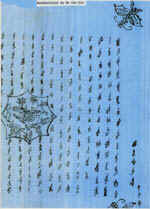 Part of the handkerchief can now be seen. Needless to say, I was very
surprized. The handwriting was beautiful--very different from a few short months before.
Part of the handkerchief can now be seen. Needless to say, I was very
surprized. The handwriting was beautiful--very different from a few short months before.
Each time I visited China after that, there was visible improvement in her hand. In 1997, He Yan-xin actually wrote out her autobiography in Nushu and gave it to me.
Note that as Ms. He also can write Hanzi, she wrote the title here: Zichuanshu自伝書 or "autobiography".
 In
her autobiography, she told of losing her father at a young age and the struggles her
mother had had trying to make ends meet. She went on to tell of not being unable to go
against her mother's wishes and being forced to marry against her will. She wrote of her
husband being sickly and of the difficulties she had had raising her five children.
In
her autobiography, she told of losing her father at a young age and the struggles her
mother had had trying to make ends meet. She went on to tell of not being unable to go
against her mother's wishes and being forced to marry against her will. She wrote of her
husband being sickly and of the difficulties she had had raising her five children.
Her autobiography filled ten pages of one of her son's school notebooks and was comprised of a total of 2828 characters. He Yan-xin was now not only able to write Nushu, but also able to express her own thoughts and feelings in it as well.
 After this, I had the occasion to come across another transmitter of Nushu.
In August of last year, a woman called He Jing-hua何静華 gave me two thin bound
booklets, one of eight pages and the other 12.
After this, I had the occasion to come across another transmitter of Nushu.
In August of last year, a woman called He Jing-hua何静華 gave me two thin bound
booklets, one of eight pages and the other 12.
These booklets were given to me with the explanation that in them Ms. He Jing Hua had written about her sorrow at losing her son.
Note that Nushu has been written on the right and Hanzi on the left. The Nushu characters are beautifully formed.
Before receiving the booklets, I
had had no idea that He Jing Hua was able to write. The year before, in September 1997,
during some field research, I had been looking for someone who knew a large number of
old poems and songs. Hearing that He Jing Hua had been known for her love of song since
childhood, and that, as an adult, she had even performed on local TV, I asked her to
recite and sing for me.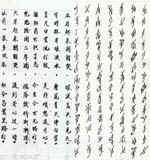 I remember
asking He Jing-hua if she could write Nushu but she instantly replied in the negative.
This left me with the impression that she had never attempted to learn how. However,
one year later, she brought me some beautiful writing in her own hand. The following is
the story of how she learned how to write Nushu.
I remember
asking He Jing-hua if she could write Nushu but she instantly replied in the negative.
This left me with the impression that she had never attempted to learn how. However,
one year later, she brought me some beautiful writing in her own hand. The following is
the story of how she learned how to write Nushu.
When He Jing-hua was a girl, she had the occasion to see and try to copy Nushu. As I mentioned before, she had loved song and its performance since childhood. When she was a girl, an aunt had given her a booklet with poems and songs written in. She had taken it and placing sheets of paper over the pages, she had tried to learn the characters by tracing them. She said she had filled countless sheets of paper with Nushu. However, she wasn't able to write without looking at the characters to copy them, not to speak of being able to write her own thoughts down, as the women of the region used to do.
It can be said that my field research was the impetus for He Jing Hua's return to learning Nushu. She tells the story this way: "It was the first time I had seen Nushu in I don't know how many years--decades even. There were a number of characters I remembered. And when, I heard Professor Endo say that Nushu was a good thing, that it was good way for women to write their own thoughts and feelings down, I thought about trying to learn again. Then after Prof. Endo went back to Japan, I looked at a the copy of Nushu she had left behind and started to practice. I asked Mr. Zhou Shuo-yi周碩沂 to teach me the characters I didn't know. Mr. Zhou Shou Yi, a local researcher, was the first person to realize the value of Nushu and has been studying it since the 1950s.
He Jing-hua had lost a son in an accident a few years before I met her. Feeling the need to express her sorrow, she composed a long poem and wrote it down in Nushu. She told me that she had decided to do so because she wanted her daughter to be able to read and understand, after her own death, how she had felt at losing him. Because her daughter cannot read Nushu, in order for her to be able to understand what she had written, He Jing-hua recited her poems out loud to her husband and had him write down Hanzi beside what she had written.
Now, He Jing-hua started attending elementary school at the age of thirteen and learned to write Hanzi at that time. Knowing this, I asked her why she did not write her poem down in hanzi instead of Nushu. She told me that she was not able to, that it was to daunting to even think about writing down her feelings in Hanzi. However, using Nushu, she felt she could. She said it took her two months to write the eight page, 94 verse, 658 character poem Jing- hua Si Er 静華思児(Jing Hua Thinks of Her Child).
6. The significance of Nushu
Now, I would like to speak about the significance of Nushu. He Jing-hua, in contrast to other transmitters before her, did not learn Nushu in an environment where women were actually using it in their daily lives. She learned it through self-study, so to speak.
However, He Jing-hua's accomplishment does suggest some possibilities in regard to Nushu:
1.) If having practiced writing Nushu as a child, it is possible for a woman at even the age of 58 to master Nushu in one year.
2.) For the women of the region, Nushu presents a simpler and more approachable mode of self-expression than Hanzi.
3.) Learning Nushu can lead to self-expression.
Looking at He Jing Hua's story, we see that this writing system, created by women long ago who did not have the opportunity to learn Hanzi and so did not know how to write it, still has significance and value today as a mode of expression in spite of opportunities for women since the revolution to go to school and learn how to read and write. He Yan Xin's expereince and her long autobiography also support this conclusion. In contrast to He Jing Hua, He Yan Xin went as far as middle school and so learned many Hanzi. After graduation, for a time, she even worked in an office as a clerk. In spite of this, it seems that her renewed ability to write Nushu was what allowed her to start expressing her own thoughts in writing.
At present, only three transmitters of Nushu remain: Yang Huan-yi, aged 90, He Yan Xin, aged 58, and the newest writer, He Jing-hua, also aged 58. Around 1989 and 1990, the local government set up Nushu classes in an attempt to have girls learn it in order to preserve and transmit the script. However, they were unable to create sustained interest among the young, and with the death of the woman who was leading the classes, they came to an end.
Since then, no one, not the local or provincial government nor even the Institute of Linguistics of the Chinese Academy of Social Studies 社会科学院語言研究所or The China Women's Federation中華全国婦女連合会 has made any attempt at preservation. It is my fervent desire to see China place greater value on this important cultural property which was created by women, transmitted by women, and has comforted and strengthened women throughout its long history.
There is still much that is unknown about this unique script and the culture it represents. And, the reality is, there is not much time left before all living transmitters of Nushu will be gone. I sincerely hope that once those of us in the international community unaware of Nushu's existence realize its value, an interest in its research and preservation will again be sparked. It is truly an important part of our world heritage and should not be allowed to disappear.
Copyright© 1999, 2000, 2001 Orie Endo.